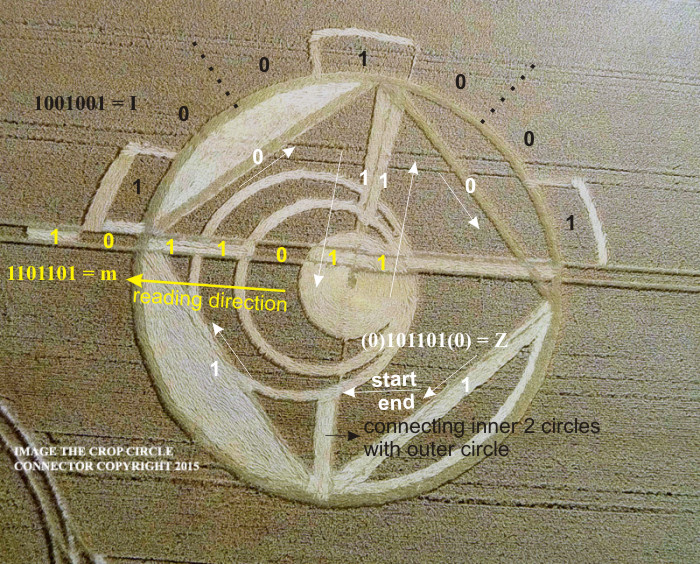|
Giving birth to
the year zero on March 1, 2016
The binary ASCII code
The formation contains several hidden
binary codes, known as ASCII. A letter in ASCII consists of 8
digital digits (0 or 1). However, in standard ASCII, the leading
digit is always 0, thus there are only 7 significant digits.
Referring to an ASCII-table, the following figure shows the results:

The outer part reads a letter
I.
The centre part reads a letter m.
This produces the result “I’m”
or “I am”.
Note that each letter at the same time
represents a word. The square in connection with two additional
lines (almost merged together) that cross the centre and start from
and end on the same point, seem to produce an additional character
(or word?). However, there are only six lines of approximately equal
length; these lines correspond with six, instead of seven digits.
This problem can be solved, when we realize that the digits are
fully symmetrical (like is the case for the letter
I).
This means that there is not only an additional leading 0 (like all
characters in standard ASCII), but also an additional trailing 0;
the leading and trailing 0 are also represented by the two circles
in the centre of the formation. The result produces the letter Z.
As the Z is connected with the circle and in this formation,
each set of digital digits seems to represent a word, the Z
very likely refers to Zero.
There are more hidden characters in the
formation, which can be found by splitting up the circle. This
results in two times four bits:

However, there are theoretically four
possibilities, that are dependent on the fact whether we read
clockwise or counter clockwise and whether we read first the inside
and then the outside, or the other way around. One possibility can
be left out of consideration, because this starts with a 1, while
standard ASCII characters always start with a 0. The result leads to
the possible letters g, v and n. This result is
very illuminating when we realize that all these possibilities
should be combined, while the fact that there is no vowel is simply
solved by the realization that the formation only produces one
vowel, namely the
I.
This results in the word giving.
Combining the results: I am giving
birth to the year zero (March 1, 2016)
Hence, we found: “I am”, “Zero”
and “giving”. When we combine these results, we get a
sentence like: I am giving Zero. However, this is a literal
“translation”. If we realize that the zero symbolizes nothingness
out of which everything is born and to which everything returns, it
is clear that the true meaning is:
“I am giving birth” or “I
am giving birth to zero” or “I am giving birth to the
year zero”.
In case that you think that this is
still speculative, it is noteworthy to realize that the formation
was found at a cemetery, which symbolizes death and (re)birth!
The square within the circle represents
the four seasons of the year. The meteorological spring starts on
March 1 and the two circles within the square and circle represent
the months of January and February. In other words, the birth of the
year zero does not start on January 1, but March 1, 2016, after the
leap day. This is fully in line with the information of other crop
circles this year.
The formation creation date
The formation was reported on Tuesday,
July 21. This is in line with the square and 7 or 8 bits of ASCII,
because this date fell exactly 4 × 8 weeks before Tuesday, March 1,
2016, the start of the year zero. There is also a connection with
the triple 1 around the edge of the circle, because the creation
date also fell exactly 3 × 4 × 7 weeks before the end of the year
zero on February 28, 2017.
Marc Smulders |